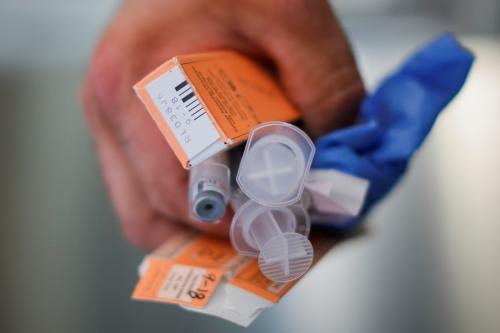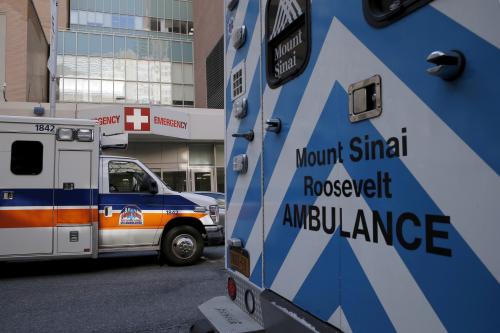On Friday, November 3, the USC-Brookings Schaeffer Initiative for Health Policy will host a discussion on policy approaches to the opioid crisis, with remarks by Congresswoman Ann Kuster, Sir Angus Deaton and Dr. Bertha K. Madras. Register here.
The opioid crisis in the United States has become so widespread and deep reaching that virtually every community in the nation has felt its effects. Enough opioids are prescribed in the U.S. each year to keep every man, woman, and child in the country medicated around the clock for one month. Opioids, including prescription medication and heroin, killed over 33,000 Americans last year—a figure almost on par with the number of Americans killed in car accidents or by gun violence every year.
The Centers for Disease Control and Prevention (CDC) reports that for chronic non-cancer pain, opioid dependence occurs in 26 percent of patients using them. Tragically, one out of every 550 patients started on opioid therapy dies from opioid-related causes a median of 2.6 years after their first prescription.
In recent research, Brookings experts have examined the far-reaching effects of the opioid crisis and shared policy recommendations for how the government can address this epidemic.
The opioid epidemic is taking a toll on children
Brookings Senior Fellows Alice Rivlin and Dayna Bowen Matthew examine the effect that the opioid crisis is having on America’s children. The Department of Health and Human Services found that nearly three quarters of states saw an unprecedented number of children entering foster care. Parental substance use was cited as the primary reason.
Just as troubling, the Centers for Disease Control reports a record increase in the number of babies born with Neonatal Abstinence Syndrome (NAS). NAS is a drug withdrawal syndrome that occurs shortly after birth, primarily among infants exposed to opioids such as prescription painkillers and heroin while they are in the womb. The number of babies born in the United States with a drug withdrawal symptom has quadrupled over the past 15 years.
The opioid crisis is affecting the U.S. labor force
Recent research by Director of the Princeton University Survey Research Center Alan B. Krueger discovered that the increase in opioid prescriptions from 1999 to 2015 could account for about 20 percent of the observed decline in men’s labor force participation (LFP) during that same period. Krueger found that over the last 15 years, LFP fell more in counties where more opioids were prescribed.
The U.S.’ demand for opioids is fueling violence in Mexico
Brookings Senior Fellow Vanda Felbab-Brown explains that the rising demand in the United States for opiates, such as heroin, is a driver of the escalating violence in Mexico, and the subsequent increase in opium poppy cultivation.
During their recent visit to Mexico, U.S. Secretary of State Rex Tillerson and Homeland Security Secretary John Kelly went to great lengths to emphasize that U.S. demand for drugs lies at the heart of Mexico’s violence problems, and committed the United States to reducing demand for drugs.
Many victims of the crisis are older, white, and legally prescribed opioids
In 2015, an estimated 2.7 million Americans suffered from opioid dependence or addiction. A common misconception is that a majority of people at risk for opioid abuse are young people using opioids without a prescription. However, people aged for 45-64 account for 40 percent of all drug overdose deaths, and a majority of these cases involved people who received legitimate prescriptions from medical providers.
Brookings Senior Fellow Carol Graham finds that uneducated, middle-aged, whites in rural areas have both the highest levels of reported stress, worry, and desperation and also have, not coincidentally, experienced the starkest increase in premature mortality due to preventable deaths such as suicide, opioid, and other drug overdoses, and heart, liver, and lung diseases. These deaths occur most frequently in the heartland “opioid belt” states (The Dakotas, Wyoming, Montana, Idaho, Wisconsin, Missouri, West Virginia, and Kentucky).
The USC-Brookings Schaffer Initiative for Health Policy’s Jason N. Doctor and Michael Menchine also say that emergency rooms are playing a significant role in the opioid crisis. First, emergency room visits are a notable source of the over-prescription of opioids—often with deadly consequences. Narcotic overdose is the eighth leading cause of death within one week of an emergency room visit.
Additionally, emergency rooms are often on the frontlines of treating those harmed by the epidemic. Currently, there are over 300,000 estimated annual emergency department visits for opioid overdose.
New policies could help mitigate the crisis
To address the crisis, Doctor and Menchine explain Congress and the Trump administration will have to focus on reducing population exposure to opioids, creating demand for safe and effective treatments, and the effective use of emergency departments. They recommend that the current administration and Congress fund additional resources to emergency rooms, including:
- The development of opioid dependence screening tools for the emergency department;
- Training to emergency department staff on how to address potentially opioid dependent individuals in an ethically neutral manner;
- The expansion of referral sources for outpatient addiction specialty clinics (particularly for uninsured patients or those with Medicaid insurance);
- Reduced administrative barriers to becoming a Buprenorphine prescriber; and
- The development of a financial reimbursement model for prescription opioid screening or treatment in emergency room settings.
The federal government has already made some progress toward addressing the crisis. As part of the 21st Century Cures Act, passed late last year, states will receive a billion dollars over two years in assistance to address the opioid epidemic. Former Brookings Expert Andrew Feldman and Harvard Medical School’s Richard Frank recommend that states launch “tiered-evidence” grant competitions in order to distribute that funding most effectively. These competitions would have three tiers to which treatment providers could apply for grant money:
- A development tier providing small grants for innovative but less-tested approaches;
- A validation tier providing medium-sized grants for approaches backed by moderate evidence; and
- A scale-up tier providing large grants for approaches supported by strong evidence.
For more information, visit the Brookings Center for Health Policy.
The Brookings Institution is committed to quality, independence, and impact.
We are supported by a diverse array of funders. In line with our values and policies, each Brookings publication represents the sole views of its author(s).






Commentary
The far-reaching effects of the US opioid crisis
October 25, 2017